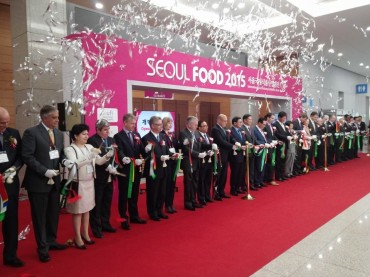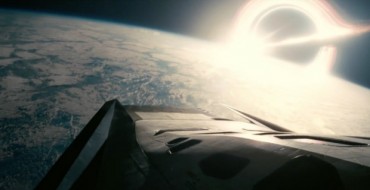
What may catch the eye of moviegoers this side of the world more than the struggles of a diminutive Hollywood superstar are the segments of the film showing Gangnam – a popular urban area – and Seoul’s Garak Market, a fish and seafood market. (Image: Lotte Entertainment)
SEOUL, Jan. 8 (Korea Bizwire) – This Thursday, the latest Matt Damon flick, “Downsizing”, premieres at cinemas across South Korea.
Its premise is built on the fantastical notion of a technology that can ‘downsize’ human beings to 5 inches in size for the purpose of combating overpopulation, and as one can expect, protagonist Matt Damon takes on this challenge with a variety of interesting consequences.

Its premise is built on the fantastical notion of a technology that can ‘downsize’ human beings to 5 inches in size for the purpose of combating overpopulation, and as one can expect, protagonist Matt Damon takes on this challenge with a variety of interesting consequences. (Image: Lotte Entertainment)
What may catch the eye of moviegoers this side of the world more than the struggles of a diminutive Hollywood superstar are the segments of the film showing Gangnam – a popular urban area – and Seoul’s Garak Market, a fish and seafood market.
Both scenes are essentially one and the same; anonymous South Koreans gaze upwards at a TV screen wearing expressions of shock and concern, while astute viewers will also notice in the background the korean words for “king crab” and “pocha” – a shortened version of the word pojangmacha, which means a drinking establishment.

Both scenes are essentially one and the same; anonymous South Koreans gaze upwards at a TV screen wearing expressions of shock and concern, while astute viewers will also notice in the background the korean words for “king crab” and “pocha” – a shortened version of the word pojangmacha, which means a drinking establishment. (Image: Lotte Entertainment)
The film’s production crew revealed that they had scoured a number of areas looking for locations that would, when seen on film, encapsulate the essence of South Korea in a moment’s notice.
“Downsizing” is only the latest in a line of blockbuster films that have featured Seoul and its outlying areas.
The first to do so was another Matt Damon-led blockbuster, “The Bourne Legacy”, released in 2012. Though the total footage of South Korea ended up amounting to only ninety seconds, the production crew stayed a week in the country, touring areas with high foot traffic such as the streets around Gangnam Station.

Anne Hathaway’s “Colossal” two years ago allocated considerably more screen time to scenes on South Korean soil, with 17 of the film’s total 109-minute running time featuring the Bucheon and Hangang Park areas. (Image: AIAS Plus)
Anne Hathaway’s “Colossal” two years ago allocated considerably more screen time to scenes on South Korean soil, with 17 of the film’s total 109-minute running time featuring the Bucheon and Hangang Park areas.
The love affair between movie lovers and superheroes is just as strong in South Korea as anywhere else, which is why the trailer for the upcoming Black Panther movie, specifically the part where the suited up Chadwick Boseman is on the streets of Busan, has set Marvel fans hearts’ a flutter.
“Avengers: Age of Ultron” released in 2015 was met with considerable anticipation by South Korean fans for the large chunk of the film in which the Avengers battle with their latest nemesis on the streets of Seoul.

The love affair between movie lovers and superheroes is just as strong in South Korea as anywhere else, which is why the trailer for the upcoming Black Panther movie, specifically the part where the suited up Chadwick Boseman is on the streets of Busan, has set Marvel fans hearts’ a flutter. (Image: Walt Disney Company Korea)
Whether due to the casting of South Korean actress Claudia Kim or the scenes of Scarlett Johansson zooming around Seoul’s highways on her motorbike, “Avengers: Age of Ultron” enjoyed a spectacular run at the domestic box office. With 10.5 million viewers, the sequel generated more revenue in South Korea than any other market excluding North America.
Last August, Marvel Comics’ editor-in-chief C.B. Cebulski thanked local fans for their support during a visit to South Korea. He also hinted at the possibility of South Korean superheroes emerging in the Marvel Universe, which undoubtedly was welcome news to many ears.
The other superhero franchise, DC Comics’ “Justice League”, did not have a moment in South Korea, but still included a scene where K-pop girl group Blackpink’s music video is playing in the background.

The other superhero franchise, DC Comics’ “Justice League”, did not have a moment in South Korea, but still included a scene where K-pop girl group Blackpink’s music video is playing in the background. (Image: Warner Bros.)
The film industry expects Hollywood to continue casting South Korea as a “supporting actor” going forward, due to the nation’s 200 million moviegoers per year, four times its population of 50 million. The large number of movie patrons makes South Korea the seventh-largest market in the world.
The government has taken a keen interest in increasing exposure South Korea’s exposure globally through foreign films, and currently covers up to 25 percent of production expenses incurred for filming done in the country.
S.B.W. (sbw266@koreabizwire.com)






